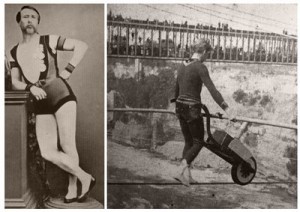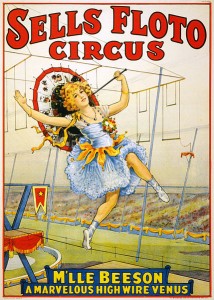
"He walked across a rope stretched at a height of 120 feet, and was nearly knocked off during a performance by a man who shot fireworks at him."
The Great Blondin was the best of all 19th-century tightrope walkers, but there were plenty of others who attempted to master the art. This quintet of stories from the Brooklyn Daily Eagle relates some of the sublime and scary moments faced by high-wire practitioners.
••••••••••
“Blondin” (February 23, 1897): “A man who was as famous in his time as the Czar of all of the Russias has just died in a suburb of London at a comfortable age. He was Blondin, the rope walker. The man had many imitators and few rivals since he came into prominence, but none of them won quite the celebrity he enjoyed. Hardly any of them earned it, in fact. It was he who first conceived the notion of crossing Niagara on a tight rope at a great height above the rushing water, and this self appointed task he carried out, once wheeling a barrow, and again with his head enveloped in a blanket, again crossing at night and again carrying a man on his back. In the grounds of the Crystal Palace in London he walked across a rope stretched at a height of 120 feet, and was nearly knocked off during a performance by a man who shot fireworks at him. He returned to America not long ago and gave exhibitions at West Brighton that were seen by many thousands. Until he was 70 years old he retained his wonderful sense of balance and agility, and could be seen throwing handsprings in front of his house in Ealing.”
••••••••••

"It was he who first conceived the notion of crossing Niagara on a tight rope...carrying a man on his back."
“Cycling on a Live Wire” (July 30, 1897): “A decided novelty in the line of tight rope performances may be witnessed free at Ridgewood Park next week. Professor Arion, who attracted considerable attention several years ago walking on a narrow span over Niagara Falls, and who has since been giving exhibitions in various parts of the country, will ride a bicycle over a live trolley wire every afternoon and evening. The feat is the latest addition to Professor Arion’s repertoire. His wheel, with the exception of the tires, is a regulation bicycle, fitted up with thirty regulation globes, which receive a current of electricity from the trolley wire beneath. The suit which the performer wears is studded with similar lights, covered wires being attached to his clothing, and when riding at a height of 75 feet above the ground, the sight is a brilliant one. In addition to the above number of tricks, Professor Arion will make up a bed on the wire, first unrolling a mattress, then covering himself with sheets and blankets.”
••••••••••
“An Insane Tight Rope Walker” (April 22, 1884): “Harry Leslie who made himself famous by crossing the Niagara Falls on a tight rope, is in a violent state of insanity. He was arrested at nine o’clock last evening by an officer of the Seventh Precinct for attempting to stab a man. His mania is said to be grief at the death of his wife which occurred some time ago, and his failure to obtain steady employment. Last evening he created a sensation at his residence, corner Monserole and Manhattan avenues, Greenpoint, by throwing a rope from an upper window and announcing his intention of walking across the street. After thinking he had fastened it to the opposite house, a crowd of about 250 persons gathered below. While the rope was dangling from the window he clutched it and climbed on the sill, from which perilous position he was rescued with difficulty.
Leslie thinks he is a wealthy man and buys blocks of property in Greenpoint for which he gives worthless checks for millions. After the occurrence of last night he was watched by a member of his family. He attempted to stab the policeman who arrested him.”
••••••••••

"A piece of burning stuff from one of the lighted torches had fallen on her head and set her long hair on fire."
“An Exciting Scene” (January 30, 1869): “An exciting scene occurred the other day at Alcazer, in Spain. Mlle. Rose Saqui, a rope dancer, was performing some jugglery feats, balancing daggers, lighted torches, etc., on the tight rope, when suddenly the cry, ‘You’re on fire’ arose from the audience. A piece of burning stuff from one of the lighted torches had fallen on her head and set her long hair on fire. With one foot on the iron rope and another in the air, the woman did not lose her presence of mind. She passed her hand over her clothes and felt nothing. ‘In your hair!’ cried the excited people. Mlle. Saqui understood, and carried her hand to her head rapidly stifled the fire. She then continued her performance as if nothing happened.”
••••••••••
“The Advocates of Women’s Rights” (July 12, 1876): “The advocates of women’s rights ought to rejoice over the fact that a woman has successfully imitated the opposite sex in one other and hitherto untried field. An Italian woman walked over Niagara Falls on a tight rope and returned, on Saturday last. She performed the feat admirably well, and proposes to repeat it, the next time carrying a man on her back. That will not be hard to do as many of her sex can attest who have, figuratively speaking, carried some worthless member of the race over all the hard places in life. If there is a man so contemptible as to be willing to be thus publicly carried on a woman’s back, his entire brotherhood who permit women this privilege in the literal sense ought to rise up against him and exterminate him. Meanwhile, let the strong minded rejoice. If they have had not any new discovery or exceptional work accomplished by their representatives as yet, they have some clever imitators among the sex, and the most recently famous of the number is this young woman who has successfully crossed Niagara Falls.”
••••••••••
